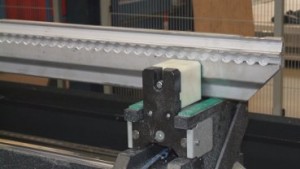Clamp management makes profile processing much faster, is gentler on the profile surfaces and increases protection against collision. The machine operator still has the option of changing the fixture positions manually if desired.
If fixtures are pulled into position by the processing portal, this takes a certain amount of time – and this applies even when fixtures have to be moved because they are occupying processing locations. If fixtures are set carefully and unnecessary movements avoided, this optimises the work cycle – the “Clamp management” module is designed to do this. It can be used both on machines that pull fixtures and on rod processing centres with autonomous fixture movement.

The eluCad module “Clamp management” optimises the positioning and movement of fixtures.
The module “Clamp management” calculates how the fixtures of the processing centres can best be used during profile processing. This depends on how many fixtures are needed at all, and in which positions they should stand. Users save a lot of time with the module: Unnecessary fixture movements are avoided and required fixture movements – on machines with autonomous movement – take place during processing.
All fixtures needed are automatically positioned by the module – sensible criteria are applied and predefined values are observed. Clamp management also helps prevent collision between fixtures, the tool and the spindle. The module shows a graphical overview of the calculated fixture positions. If desired, manual intervention is possible: The machine operator can place fixtures wherever he wants them, or change fixture positions later.
Configuration options
Clamp management offers configuration options: These include the distance between two fixtures, the distance between fixtures and the ends of the profile and the distance between fixtures and the first processing on the profile ends.
To achieve optimum fixture positions and short work cycles, clamp management proceeds as follows: Information is collected about which processes must be carried out on the profile. The module also handles information about possible collision bodies – that is, it takes the dimensions of the fixtures and tools into consideration. Finally, the module also examines how many fixtures are available on the rod processing centre and to what extent each of them can move. What safety settings are there? What parameters has the machine operator configured? – These are also taken into consideration by clamp management.
The module calculates with all the information collected, then attempts to position the fixtures in such a way that during rod processing the least possible number of fixture movements is required. For example, the module will not place fixtures in places where processing will still be required if it can be avoided.

The “Clamp management” module does not place fixtures in positions where processing is required, or moves fixtures during processing in such a way that the profile rod is always held securely.
If necessary, multiple clamping situations can be output. Clamp management always tries to keep the number of fixture situations as low as possible. Even while the program is running, the module can move fixtures to make room for processing. Here, the program is careful to ensure that the profile rod always stays securely clamped.
Numerous Advantages
The machine operator can influence clamp management: For example, safety distances can be used to determine how near fixtures can come to a possible collision body. The parameters “Maximum distance between two fixtures”, “Fixture distance to the end of the profile” or “Fixture distance to first process” also permit the machine operator to make specifications that the module then implements.
In all, clamp management offers the following advantages:
- Fixtures can be set fully automatically
- Time savings due to fewer clamp movements
- Time savings because the operator has less to enter
- Profile surfaces scratch less because the number of fixture movements is reduced
- Collision-monitored movement of fixtures and collision avoidance by the module
- Safety for the operator
- Fixture positions can be edited by the operator afterwards
- Fixtures can be manually set by the operator
- Fixture movements are reduced to the minimum
- Very cost-effective procedure

With the eluCad chuck management module, you can
control 20 chucks so you can work smoothly.
Fixture movements are reduced to the absolutely necessary.
You save time, protect the profile surface, and work
very economically.
